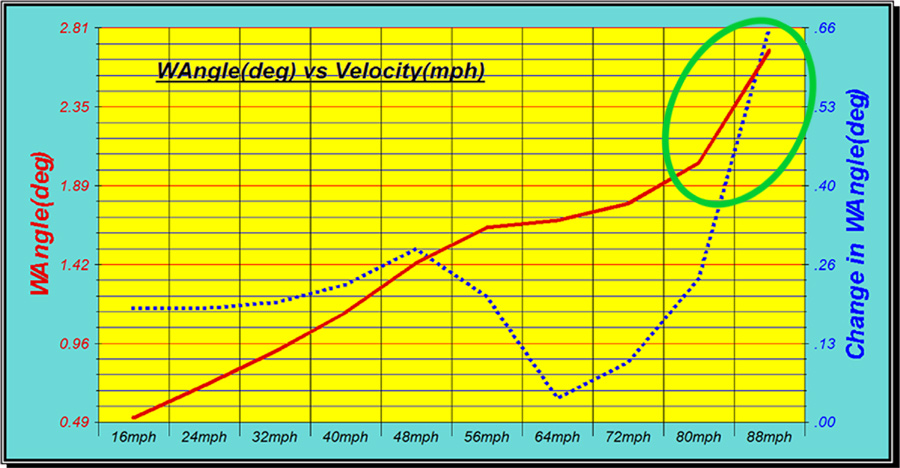|
|
|
 |
Advanced Aerodynamic and Hydrodynamic |
| Performance Boat design and setup secrets for Recreational tunnels, Offshore Cats, Racing tunnels, Fishing/Utility hulls, Vee and Vee-Pad Hulls, Bass Boats | |
| Home New About Us Technical Articles TBPNews Archives FREE Downloads Research Contact Us | |
|
Testimonials
Reviews
Join TBPNews
Advertise
Search
Buy Now
|
|
|
|
|
|
About TBDP |
Features |
How it Works |
Design Inputs | Perf
Outputs | Screens |
Reports | VBDP | Testimonials
|
Our Methods |
Reviews | Updates |
Videos | Order
|
||
| TBDP©/VBDP© 'Maximum Velocity' (Velocity Analysis)' | ||
| Get complete article by email request: | Share: | |
| BREAKTHROUGH! | ||
| 'Velocity Optimization Analysis' by AR's unique analysis and TBDP©/VBDP© software. | ||
|
TBDP©/VBDP© software's
'Optimize=Velocity' analysis can complete performance checks to
find required Trim Angle (WAngle), using maximum Power Available,
to satisfy loading solutions at any velocity.
With 'Auto WAngle' feature, an analysis can be completed
through the full operating velocity range to ultimately establish
a 'Maximum Limiting Velocity' - there is no other Power/Trim
Angle solutions beyond this MLVelocity. All hull performance characteristics
can be calculated throughout this full velocity range to show operating
and dynamic stability responses.
Maximum Limiting Velocity - The above analysis procedure importantly establishes the potential maximum velocity that the hull could achieve based
on available Power and unlimited Trim Settings. This establishes a velocity bounding, but disregards stability influences that could
further limit real attainable velocity. Further analysis (using: Angle Optimization or Power Optimization or Economy Optimization)
is necessary to examine the performance results to consider Dynamic Stability characteristics and safe operating settings, and so to
determine Practical Achievable Velocity.
For example, there are often (usually) stability issues that
occur at a velocity less than MLVelocity that can prevent the boat
from getting to the theoretical maximum.
It's important to recognize these differences.onset of instability
is the change in rate of required full power "WAngle"
(trim angle) through the velocity range. If the required "WAngle"
increases to very high values or the 'rate-of-change' of WAngle
shows dramatic change (+ or -), then the upper velocity limit of
the hull design and setup may be related. If this maximum velocity
and rate of required WAngleto reach Vmax is acceptable
to you then ok - otherwise you may want to modify design, setup
or operating characteristics accordingly. |
||
 Maximum Practical Velocity - When a key performance characteristic, such as trim angle, or
dynamic stability change) shows a significant change this may indicate
that the hull/setup is in the region of 'Maximum Practical Velocity'.
TBDP/VBDP software
analyzes derivative (rate at which a function is changing at a given
point) of key performance indicators (eg: δxCFDynamic/δV, δTrimAngle/δV, δPorpoise/δV)
to calculate key velocity of inflection to predict critical operating
velocities.
Maximum Practical Velocity - When a key performance characteristic, such as trim angle, or
dynamic stability change) shows a significant change this may indicate
that the hull/setup is in the region of 'Maximum Practical Velocity'.
TBDP/VBDP software
analyzes derivative (rate at which a function is changing at a given
point) of key performance indicators (eg: δxCFDynamic/δV, δTrimAngle/δV, δPorpoise/δV)
to calculate key velocity of inflection to predict critical operating
velocities.
This is often seen as a significant change in required 'Trim Angle (WAngle)', 'Dynamic Stability' or 'Hump/Transition Zone' or other key indicators. Operating velocities greater than this MPVelocity value may be approaching a region of unstable or unsafe operation for this hull/setup. TBDP©/VBDP© software can generate a series of analyses to establish the velocity that is evaluated as 'maximum Practical Velocity'. This is a unique analysis (using Angle Optimization or Power Optimization or Economy Optimization) of trends and significant changes of key performance results that can indicate that the hull/setup is in the region of 'Maximum Practical Velocity', which is less than 'Maximum Limiting Velocity' and represents more practical region of stability. Note: All of these (above) steps can be done automatically using the 'Auto 1-2-3 Performance Analysis Wizard' to guide you through the 3 steps of Velocity, WAngle and Power Analysis.
|
||
|
Test Velocity - Alternatively, TBDP/VBDP can "Set for TEST Velocity" which will automatically set the program parameters to calculate the Velocity at a specified Trim Angle (START ANGLE). This option is useful when evaluating the effect of small design configuration changes or dimensional changes on performance and velocity. For example, the complete performance effect of increasing a vee-pad hull PADWIDTH from 12" to 13" can be quickly shown using this option. [NOTE: that the quantified effect on performance of very small changes (such as the example above) will represent predicted results under ideal operating conditions. These ideal conditions are of course, not always representative of typical operating situations, as there are many other factors that can also impact performance like water conditions, acceleration modes, handling/cornering conditions, etc. The absolute predicted changes in say, velocity, can effectively be used for design evaluation purposes - you will now know what the potential performance improvement or degradation could be AT THE VELOCITY TESTED.]
|
||
|
|
||
|
Performance Analysis/Optimization
Options - TBDP/VBDP can employ 4 different Optimizing methods
of performance analysis, each highlighting different performance
scenerios and features. Get full performance data,data
points for chosen analysis method: Each optimizing method presents comprehensive performance results measures through full operating velocity range, detailed hull performance characteristics. |
||
|
[more about AR's research more about AR's publications and technical articles/papers] |
||

